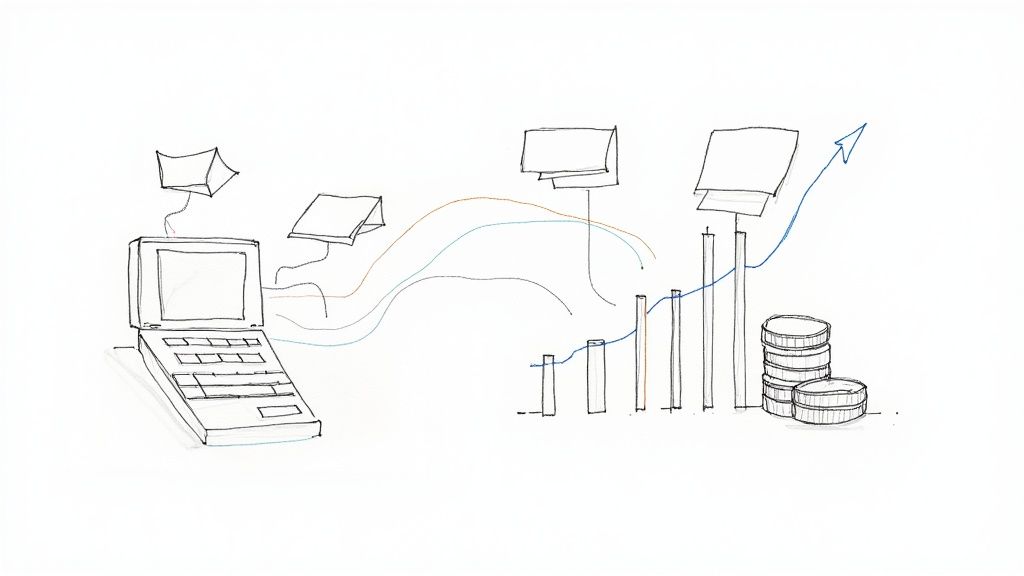
Your Guide to a Return On Ad Spend Calculator
Boost campaign profits with our simple return on ad spend calculator. Learn the ROAS formula, how to calculate it, and strategies to improve your results today.

Getting new customers is changing fast! It's not just about one way anymore. Think about reaching people everywhere they are – online, on social media, even through email. In 2025, using smart tools to find these people automatically is key. This approach, called automated lead generation, helps businesses grow without needing a huge team or spending tons of money. We’ll look at how to make it work for you.

Getting people interested in what you offer without breaking the bank is totally doable in 2025. It’s all about being smart with your approach. We're talking about building systems that bring in potential customers consistently, so you're not constantly scrambling. The goal is to create a steady flow of interested individuals who are genuinely likely to become customers.
Artificial intelligence isn't just for the big players anymore. Tools are popping up that let even small businesses reach out to more people without needing a huge team. Think about automated emails that sound personal or chatbots that can answer common questions 24/7. These AI helpers can sift through data to find the best people to talk to, making your outreach much more effective. It’s like having a super-efficient assistant who never sleeps.
Putting all your hopes on one way to get leads is a risky move. What if that one channel suddenly stops working? It’s much smarter to have several different ways people can find you. This could be through helpful blog posts, word-of-mouth referrals, or engaging on social media. When you spread your efforts across different areas, your business is much safer if one strategy hits a snag. It’s like having multiple streams feeding into your main water supply – if one gets blocked, you still have water.
Here are a few ways to diversify:
While paid ads can bring quick results, there's something special about leads that come to you naturally. People who find you through search engines, social shares, or recommendations often trust you more from the start. This organic interest usually leads to better conversion rates and a stronger, more loyal customer base. It takes time to build, but the payoff in terms of trust and long-term growth is significant. It’s about attracting people who are already looking for what you provide, rather than interrupting them.
Focusing on organic methods means you're building a sustainable engine for growth. It's less about shouting the loudest and more about being genuinely helpful and discoverable when people need you. This approach builds a foundation of trust that paid methods often struggle to replicate.
Okay, so we've talked about getting leads in the door, but what happens next? That's where AI really starts to shine. Think of it like this: you've got a pile of potential customers, but some are ready to buy now, some need a little nudge, and some are just browsing. AI helps sort that out, fast.
Bad data is like trying to build a house with rotten wood. It just doesn't work. AI steps in to clean up and fill in the blanks in your lead information. It can find missing phone numbers, correct email addresses, and even figure out company sizes and industries. This means your sales team isn't wasting time chasing ghosts or sending emails to the wrong people. Accurate data makes every sales interaction more effective.
This is where AI gets really smart. It looks at all the data you have – website visits, email opens, past purchases – and figures out which leads are most likely to become paying customers. It assigns a score to each lead, so your sales team knows who to focus on first. Predictive analytics takes it a step further, guessing what a lead might do next based on patterns. It's like having a crystal ball for your sales pipeline.
Here's a quick look at what AI can do:
Imagine a lead visits your pricing page for the second time today. AI can spot this and trigger an automated follow-up, maybe a chat message or a personalized email, right when they're most interested. This real-time engagement is huge. It shows the lead you're paying attention and can answer their questions before they even ask them. It's about being there at the perfect moment, not too early, not too late.
The goal isn't just to have more leads, but to have better leads that are ready for your sales team. AI makes this possible by making your data work harder and smarter for you.
Alright, let's talk about the gear you'll need to get this automated lead generation thing rolling. You don't need a massive budget to start, which is pretty cool. There are a bunch of free and low-cost options out there that can really make a difference.
Think of your CRM as your command center. It's where all your lead information lives, gets organized, and where you can start tracking what's happening. For free options, HubSpot CRM is a solid choice. It helps you manage contacts, track interactions, and even score leads based on their activity. It's not just about storing names; it's about understanding who's interested and why. Pair that with Google Analytics, and you've got a powerful duo. Google Analytics shows you where your website visitors are coming from, what they do on your site, and which pages are actually getting results. This data is gold for figuring out what's working and what's not. You can see which traffic sources bring in the most engaged visitors and where people might be dropping off.
Keeping track of your leads and understanding your website's performance doesn't have to cost a fortune. Free tools can provide a lot of insight if you know how to use them.
Once you've got leads coming in, you need to talk to them. Email is still a big player here. Tools like Mailchimp (they have a free tier) or Sender.net let you build email lists and send out automated sequences. This means you can set up welcome emails, follow-ups, or even nurture campaigns that go out automatically when someone takes a specific action. It saves you a ton of time. On the social media front, managing multiple platforms can be a headache. Tools like Buffer or Hootsuite (again, check their free plans) allow you to schedule posts in advance. This keeps your social presence consistent without you having to be online all the time. It's about being present and engaging without being glued to your screen.
People aren't going to give you their contact info for nothing. You need to offer them something valuable, like an ebook, a checklist, or a helpful guide. Canva is fantastic for creating visually appealing lead magnets and social media graphics, even with its free version. For figuring out what people are actually searching for, tools like Ubersuggest can help with SEO and keyword research. Knowing what terms your potential customers use helps you create content that they'll actually find. This research is key to making sure your content gets seen. If you're looking for AI-powered tools to help with lead enrichment and workflow flexibility, Clay offers great options.
Using these tools together can create a pretty smooth operation. You can research topics, create content, schedule social posts, and manage your email outreach, all without breaking the bank. It's about building a system that works for you.
So, you've got your automated systems humming, pulling in leads like a charm. That's great, but the job isn't done. Think of it like a leaky faucet; you can keep filling a bucket, but if there's a hole, you're just wasting water. Optimizing your lead generation funnel is all about plugging those leaks and making sure every bit of effort counts. It’s about turning those initial contacts into actual customers, smoothly and efficiently.
First things first, you need to know what 'good' looks like. Without clear goals, you're just guessing. What are you actually trying to achieve? More demo requests? Higher conversion rates on a specific offer? Pinpointing these numbers is step one. These aren't just random numbers; they're your roadmap.
Here are some common metrics to consider:
You can't improve what you don't measure. Make sure your tracking is set up correctly from the start, using tools like Google Analytics or your CRM's built-in reporting. Don't get caught up in vanity metrics like website visits if they don't translate into actual business.
Your funnel isn't a 'set it and forget it' kind of thing. The digital world changes fast, and what worked last month might not work today. This is where testing comes in. You need to be constantly tweaking things to see what gets the best results. Small changes can make a big difference.
Think about A/B testing different elements:
Keep a record of your tests and their outcomes. This data will guide your future decisions, moving you away from guesswork and towards a data-driven approach. It’s an ongoing process, not a one-time fix.
Not every lead is ready to buy right now, and that's okay. The trick is to figure out who's hot and who's not, so your sales team doesn't waste time chasing dead ends. Lead scoring helps with this. You assign points based on a lead's actions and profile.
For example:
By scoring leads, you can automatically prioritize those who show the most interest and fit your criteria. This means your sales team can focus their energy where it's most likely to pay off, leading to better efficiency and higher close rates. It’s about working smarter, not just harder.
Look, generating leads sounds great, and it is, but it's easy to mess things up if you're not careful. It's not just about getting names and emails; it's about getting the right names and emails, and then actually doing something with them. I've seen too many businesses pour time and effort into lead gen, only to watch it all go to waste because they tripped over one of these common mistakes.
Trying to get all your leads from just one place is like putting all your money into one stock. If that stock tanks, you're in trouble. The same goes for lead generation. Maybe you're crushing it on LinkedIn right now, but what happens if their algorithm changes or they decide to charge more for business accounts? Poof, your lead flow could dry up overnight. It’s way smarter to spread things out.
Diversifying means if one channel slows down, others can pick up the slack. It makes your whole operation much more stable.
So, you got a lead. Great! Now what? Too many people get a lead and then just... wait. Or worse, they send one generic email and call it a day. That's not how you build relationships or close deals. People are busy, and they often need multiple touchpoints before they're ready to buy. You need a plan for what happens after someone becomes a lead.
Think of it like this: you wouldn't propose on the first date, right? Lead nurturing is the dating process for your business. You get to know them, show them you're a good match, and build trust over time. Skipping this step means you're leaving potential sales on the table.
This means having automated email sequences that send helpful content, personalized messages based on their interests, and clear calls to action when they seem ready. It’s about guiding them along, not just pestering them.
If you're not measuring, you're just guessing. It's like driving without a dashboard. How do you know if you're going too fast, running out of gas, or even heading in the right direction? You need to know what's working and what's not.
Here’s a quick look at what you should be watching:
Using tools like Google Analytics or a free CRM can show you where your leads are coming from, how they behave on your site, and which campaigns are actually bringing in business. Without this data, you're just throwing money and time at the wall hoping something sticks. Regularly reviewing these numbers is how you actually improve and grow.

So, where is all this automated lead generation headed? It's not really a surprise that things are always changing, right? What worked last year might not cut it next year. The big picture is that businesses need to keep up with how people are interacting with brands. It's all about making things smooth and easy for potential customers, no matter how they find you. But here's the thing: while automation is great for handling the heavy lifting, like sending out initial emails or sorting through basic inquiries, it can't replace genuine human connection. The most successful strategies will blend the efficiency of machines with the empathy and understanding of people. Think of it like this: AI can identify a potential customer's needs based on data, but a human can build rapport and trust by truly listening and responding with care. This hybrid approach means using automated tools to handle the volume and repetitive tasks, freeing up your sales team to focus on those high-value conversations that actually close deals. It’s about making technology work for us, not replacing us entirely.
Data privacy is becoming a really big deal, and it’s only going to get more important. People are more aware of how their information is being used, and regulations are catching up. This means that as we use more automated tools to gather and process leads, we have to be super careful about how we handle personal data. We can't just collect everything and hope for the best anymore. It's about being transparent with people about what data we're collecting and why, and making sure we have their permission. This isn't just about following the rules; it's about building trust. If people feel like their privacy is respected, they're more likely to engage with your business. So, the future of lead generation has to be built on a foundation of privacy-first practices. This means looking at tools and methods that are designed with privacy in mind from the start.
As AI takes on more of the initial lead generation and qualification work, sales teams need to adapt. They can't just rely on the old ways of doing things anymore. This means getting training on how to work with these new AI tools. It’s not about becoming tech wizards, but about understanding how to interpret the data AI provides and how to use it to have more meaningful conversations. For example, AI can score leads and tell you who is most likely to buy, but a salesperson still needs to know how to approach that lead with the right message. They need to be good at building relationships and solving problems, using the insights from AI to guide them. Investing in training for your sales team is key to making sure they can keep up and actually benefit from all this new technology. It helps them do their jobs better and makes the whole sales process more effective.
Here's a quick look at what sales teams might focus on:
So, we've gone over a bunch of ways to get more leads without spending a ton of cash in 2025. It's not just about finding leads, though. It's about getting the right leads and then actually talking to them. Using tools, even the free ones, can really help sort through the noise and figure out who's actually interested. Remember, don't put all your faith in just one method; mix it up. And keep an eye on what's working and what's not, then adjust. It’s a constant thing, this lead generation stuff, but getting it right means your business can keep growing. It’s definitely worth the effort.
Automated lead generation is like having a super-helpful robot that finds people who might be interested in what you sell. It uses special computer programs to find these people automatically, so your team doesn't have to do all the searching by hand. This helps you get more potential customers without doing extra work.
AI, which stands for Artificial Intelligence, is like a smart brain for your computer programs. It can help find leads much faster and better than humans. AI can figure out who is most likely to buy from you and even help send them personalized messages, making it easier to connect with them.
Lead enrichment means adding more helpful details to the information you already have about a potential customer. Imagine you have someone's name, but lead enrichment helps you find their job title, company, and what they might be interested in. This makes it easier for your sales team to talk to them about the right things.
Yes, there are! Many great tools can help you find and manage leads without costing money. Things like free versions of CRM software, email marketing tools, and social media schedulers can make a big difference. You can use these to get started and grow your business.
A big mistake is only using one way to find leads. If that one way stops working, you won't get any new customers. It's much better to use several different methods, like social media, content, and email, so you always have a steady flow of potential customers.
Absolutely! Automation is great for finding and doing the basic tasks, but talking to people is still super important. It helps build trust and relationships. Think of automation as helping your team so they have more time to have meaningful conversations with the best potential customers.